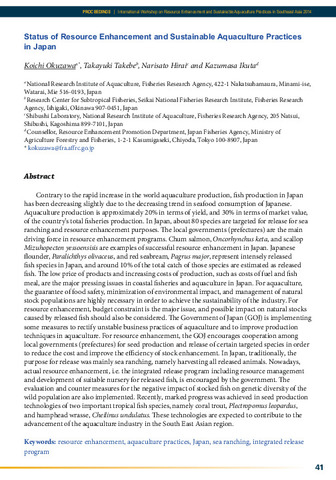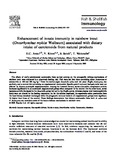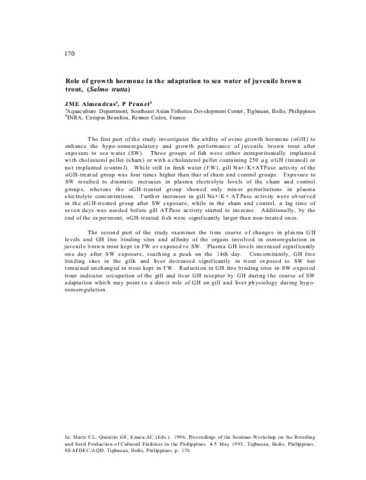| dc.contributor.author | Araki, Hitoshi | |
| dc.contributor.editor | Romana-Eguia, Maria Rowena R. | |
| dc.contributor.editor | Parado-Estepa, Fe D. | |
| dc.contributor.editor | Salayo, Nerissa D. | |
| dc.contributor.editor | Lebata-Ramos, Ma. Junemie Hazel | |
| dc.date.accessioned | 2016-01-19T09:59:22Z | |
| dc.date.available | 2016-01-19T09:59:22Z | |
| dc.date.issued | 2015 | |
| dc.identifier.citation | Araki, H. (2015). Rapid adaptation to a new environment: is it reversible? In M. R. R. Romana-Eguia, F. D. Parado-Estepa, N. D. Salayo, & M. J. H. Lebata-Ramos (Eds.), Resource Enhancement and Sustainable Aquaculture Practices in Southeast Asia: Challenges in Responsible Production of Aquatic Species: Proceedings of the International Workshop on Resource Enhancement and Sustainable Aquaculture Practices in Southeast Asia 2014 (RESA) (pp. 19-24). Tigbauan, Iloilo, Philippines: Aquaculture Dept., Southeast Asian Fisheries Development Center. | en |
| dc.identifier.isbn | 9789719931041 | |
| dc.identifier.uri | http://hdl.handle.net/10862/2760 | |
| dc.description.abstract | Accumulating evidence suggests rapid adaptation of fish populations when they are exposed to artificial hatchery environments. However, little is known if rapidly-adapted populations can readapt to their original, natural environment at the same rate. Here, I review recent studies on salmonid fish that address this issue. They indeed suggest rapid adaptation of hatchery populations, in which reproductive fitness under a natural environment became much lower than that in the wild population after only 1-2 generations of captive breeding. However, the reproductive fitness did not recover after one generation of natural rearing, implying that rapid adaptation to a new environment was not reversible at the same rate. I discuss potential consequences of the irreversible fitness reduction in extensively stocked fish species. Understanding the mechanism behind the irreversible rapid adaptation in fish populations will help us figure out a better, nature-friendly, and hence sustainable means of hatchery operations for human welfare. | en |
| dc.language.iso | en | en |
| dc.publisher | Aquaculture Department, Southeast Asian Fisheries Development Center | en |
| dc.subject | hatcheries | en |
| dc.subject | Salmo trutta | |
| dc.subject | Oncorhynchus gorbuscha | |
| dc.subject | Oncorhynchus mykiss | |
| dc.subject | Salmonidae | |
| dc.subject | Oncorhynchus tshawytscha | |
| dc.subject | Oncorhynchus kisutch | |
| dc.subject | Fish stocking | en |
| dc.subject | Rapid adaptation | en |
| dc.subject | Reproductive fitness | en |
| dc.subject | Salmonid species | en |
| dc.title | Rapid adaptation to a new environment: is it reversible? | en |
| dc.type | Conference paper | en |
| dc.citation.spage | 19 | |
| dc.citation.epage | 24 | |
| dc.subject.asfa | Adaptations | en |
| dc.subject.asfa | breeding | en |
| dc.subject.asfa | Anadromous species | en |
| dc.subject.asfa | behaviour | en |
| dc.subject.asfa | stocks | en |
| dc.subject.asfa | culture effects | en |
| dc.subject.asfa | reproduction | en |
| dc.subject.asfa | reproductive behaviour | en |
| dc.subject.asfa | cultured organisms | en |
| dc.subject.asfa | fish culture | en |
| dc.citation.conferenceTitle | Resource Enhancement and Sustainable Aquaculture Practices in Southeast Asia: Challenges in Responsible Production of Aquatic Species: Proceedings of the International Workshop on Resource Enhancement and Sustainable Aquaculture Practices in Southeast Asia 2014 (RESA) | en |



